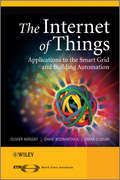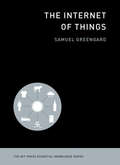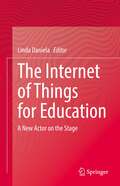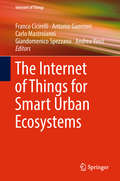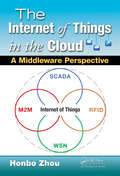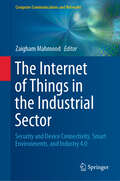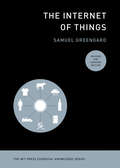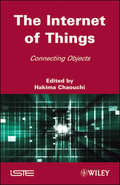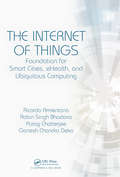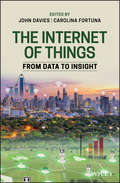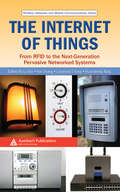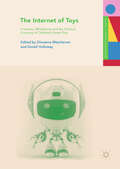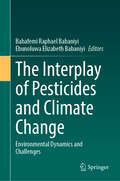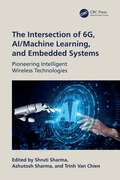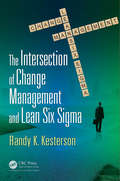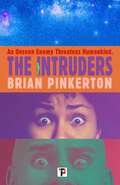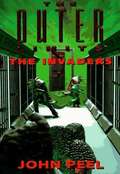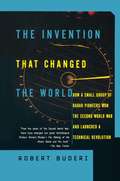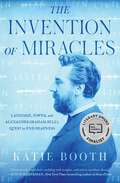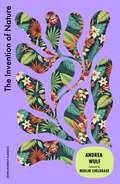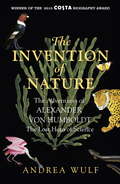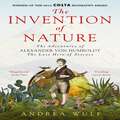- Table View
- List View
The Internet of Things
by Olivier Hersent Omar Elloumi David BoswarthickAn all-in-one reference to the major Home Area Networking, Building Automation and AMI protocols, including 802.15.4 over radio or PLC, 6LowPAN/RPL, ZigBee 1.0 and Smart Energy 2.0, Zwave, LON, BACNet, KNX, ModBus, mBus, C.12 and DLMS/COSEM, and the new ETSI M2M system level standard. In-depth coverage of Smart-grid and EV charging use cases.This book describes the Home Area Networking, Building Automation and AMI protocols and their evolution towards open protocols based on IP such as 6LowPAN and ETSI M2M. The authors discuss the approach taken by service providers to interconnect the protocols and solve the challenge of massive scalability of machine-to-machine communication for mission-critical applications, based on the next generation machine-to-machine ETSI M2M architecture. The authors demonstrate, using the example of the smartgrid use case, how the next generation utilities, by interconnecting and activating our physical environment, will be able to deliver more energy (notably for electric vehicles) with less impact on our natural resources.Key Features:Offers a comprehensive overview of major existing M2M and AMI protocols Covers the system aspects of large scale M2M and smart grid applications Focuses on system level architecture, interworking, and nationwide use casesExplores recent emerging technologies: 6LowPAN, ZigBee SE 2.0 and ETSI M2M, and for existing technologies covers recent developments related to interworkingRelates ZigBee to the issue of smartgrid, in the more general context of carrier grade M2M applications Illustrates the benefits of the smartgrid concept based on real examples, including business casesThis book will be a valuable guide for project managers working on smartgrid, M2M, telecommunications and utility projects, system engineers and developers, networking companies, and home automation companies. It will also be of use to senior academic researchers, students, and policy makers and regulators.
The Internet of Things (The MIT Press Essential Knowledge series)
by Samuel GreengardA guided tour through the Internet of Things, a networked world of connected devices, objects, and people that is changing the way we live and work.We turn on the lights in our house from a desk in an office miles away. Our refrigerator alerts us to buy milk on the way home. A package of cookies on the supermarket shelf suggests that we buy it, based on past purchases. The cookies themselves are on the shelf because of a “smart” supply chain. When we get home, the thermostat has already adjusted the temperature so that it's toasty or bracing, whichever we prefer. This is the Internet of Things—a networked world of connected devices, objects, and people. In this book, Samuel Greengard offers a guided tour through this emerging world and how it will change the way we live and work.Greengard explains that the Internet of Things (IoT) is still in its early stages. Smart phones, cloud computing, RFID (radio-frequency identification) technology, sensors, and miniaturization are converging to make possible a new generation of embedded and immersive technology. Greengard traces the origins of the IoT from the early days of personal computers and the Internet and examines how it creates the conceptual and practical framework for a connected world. He explores the industrial Internet and machine-to-machine communication, the basis for smart manufacturing and end-to-end supply chain visibility; the growing array of smart consumer devices and services—from Fitbit fitness wristbands to mobile apps for banking; the practical and technical challenges of building the IoT; and the risks of a connected world, including a widening digital divide and threats to privacy and security. Finally, he considers the long-term impact of the IoT on society, narrating an eye-opening “Day in the Life” of IoT connections circa 2025.
The Internet of Things for Education: A New Actor on the Stage
by Linda DanielaThis book is about the Internet of Things in the field of education. Specifically, it focuses on two major topics: IoT (Internet of Things) solutions to support distance education and new pedagogical approaches to support development of computational thinking with educational devices possessing the characteristics of IoT. As the educational landscape has dramatically changed in times of global pandemic, online resources and media, such as IoT, have become increasingly important. This situation compels all educational scholars, researchers and practitioners to search for new solutions, new educational pathways and new agents for knowledge development to support learning. This book presents the possibilities of IoT as both a catalyst and performance tool for education. The convergence of multiple technologies, real-time analytics, machine learning, commodity sensors, and embedded systems can serve as tools for learning support and this book details exactly how these powerful tools can be utilized to best effect.
The Internet of Things for Smart Urban Ecosystems (Internet of Things)
by Antonio Guerrieri Giandomenico Spezzano Franco Cicirelli Carlo Mastroianni Andrea VinciThe main objective of this book is to provide a multidisciplinary overview of methodological approaches, architectures, platforms, and algorithms for the realization of an Internet of Things (IoT)-based Smart Urban Ecosystem (SUE). Moreover, the book details a set of real-world applications and case studies related to specific smart infrastructures and smart cities, including structural health monitoring, smart urban drainage networks, smart grids, power efficiency, healthcare, city security, and emergency management. A Smart Urban Ecosystem (SUE) is a people-centric system of systems that involves smart city environments, applications, and infrastructures. SUEs require the close integration of cyber and physical components for monitoring, understanding and controlling the urban environment. In this context, the Internet of Things (IoT) offers a valuable enabling technology, as it bridges the gap between physical things and software components, and empowers cooperation between distributed, pervasive, and heterogeneous entities.
The Internet of Things in the Cloud: A Middleware Perspective
by Honbo ZhouAlthough the Internet of Things (IoT) is a vast and dynamic territory that is evolving rapidly, there has been a need for a book that offers a holistic view of the technologies and applications of the entire IoT spectrum. Filling this void, The Internet of Things in the Cloud: A Middleware Perspective provides a comprehensive introduction to the Io
The Internet of Things in the Industrial Sector: Security and Device Connectivity, Smart Environments, and Industry 4.0 (Computer Communications and Networks)
by Zaigham MahmoodThis book has a focus on the development and deployment of the Industrial Internet of Things (IIoT) paradigm, discussing frameworks, methodologies, benefits and limitations, as well as providing case studies of employing the IoT vision in the industrial domain. IIoT is becoming an attractive business reality for many organisations such as manufacturing, logistics, oil and gas, energy and other utilities, mining, aviation, and many more. The opportunities for this paradigm are huge, and according to one report, the IIoT market is predicted to reach $125 billion by 2021. The driving philosophy behind the IIoT is that smart machines are better than humans at accurately capturing, analysing and communicating real-time data. The underlying technologies include distributed computing, machine learning, artificial intelligence, and machine-to-machine communication, with a typical IIoT system consisting of intelligent systems (applications, controllers, sensors, and security mechanisms), data communication infrastructure (cloud computing, edge computing, etc.), data analytics (to support business intelligence and corporate decision making), and most importantly the human element. The promised benefits of the IIoT include enhanced safety, better reliability, smart metering, inventory management, equipment tracking, and facilities management. There are, however, numerous issues that are also becoming the focus of active research, such as concerns regarding service availability, data security, and device communication. Lack of ubiquitous interoperability between heterogeneous devices is also a major concern. This book intends to fill a gap in the IIoT literature by providing the scientific contributions and latest developments from researchers and practitioners of international repute, focusing on frameworks, methodologies, benefits, and inherent issues/barriers to connected environments, especially in industrial settings.The intended audience includes network specialists, hardware engineers, and security experts who wish to adopt newer approaches for device connectivity, IoT security, and sensor-based devices design. University level students, researchers and practitioners will also find the latest innovation in technology and newer approaches relevant to the IIoT from a distributed computing perspective.
The Internet of Things, revised and updated edition (The MIT Press Essential Knowledge series)
by Samuel GreengardA guided tour of the rapidly evolving networked world of connected devices, objects, and people that is changing the way we live and work.Since the publication of the original edition of this volume in the MIT Press Essential Knowledge series, the Internet of Things (IoT) has evolved from a novelty (look! my phone connects to my lamp!) to a mainstream technology framework that we rely on every day to accomplish many tasks. This revised and updated edition reports on the latest developments in this rapidly evolving networked world of connected devices, objects, and people that is changing the way we live and work. Business and technology writer Samuel Greengard takes us on a guided tour of the IoT, describing smart lightbulbs, sensors in phones that trigger earthquake warnings, 3D headsets that connect users to business expos through completely immersive virtual reality environments, and more. He offers a clear explanation of the technology that builds and manages the IoT and examines the growing array of consumer devices now available, from smart door locks to augmented reality fitting rooms. Greengard also shows how the IoT is part of the Fourth Industrial Revolution, which is transforming business through smart manufacturing, end-to-end supply chain visibility, integrated artificial intelligence, and much more. He considers risks associated with the IoT, including threats to free speech, growing inequality, and an increase in cybercrime. Finally, he takes a look at the future of a hyperconnected world and what it means to people and human interaction.
The Internet of Things: Connecting Objects to the Web (Lecture Notes Of The Institute For Computer Sciences, Social Informatics And Telecommunications Engineering Ser. #170)
by Hakima ChaouchiInternet of Things: Connecting Objects puts forward the technologies and the networking architectures which make it possible to support the Internet of Things. Amongst these technologies, RFID, sensor and PLC technologies are described and a clear view on how they enable the Internet of Things is given. This book also provides a good overview of the main issues facing the Internet of Things such as the issues of privacy and security, application and usage, and standardization.
The Internet of Things: Foundation for Smart Cities, eHealth, and Ubiquitous Computing (Advances In Information Security, Privacy, And Ethics Ser.)
by Ricardo Armentano, Robin Singh Bhadoria, Parag Chatterjee and Ganesh Chandra DekaThis book provides a dual perspective on the Internet of Things and ubiquitous computing, along with their applications in healthcare and smart cities. It also covers other interdisciplinary aspects of the Internet of Things like big data, embedded Systems and wireless Sensor Networks. Detailed coverage of the underlying architecture, framework, and state-of the art methodologies form the core of the book.
The Internet of Things: From Data to Insight
by John DaviesProvides comprehensive coverage of the current state of IoT, focusing on data processing infrastructure and techniques Written by experts in the field, this book addresses the IoT technology stack, from connectivity through data platforms to end-user case studies, and considers the tradeoffs between business needs and data security and privacy throughout. There is a particular emphasis on data processing technologies that enable the extraction of actionable insights from data to inform improved decision making. These include artificial intelligence techniques such as stream processing, deep learning and knowledge graphs, as well as data interoperability and the key aspects of privacy, security and trust. Additional aspects covered include: creating and supporting IoT ecosystems; edge computing; data mining of sensor datasets; and crowd-sourcing, amongst others. The book also presents several sections featuring use cases across a range of application areas such as smart energy, transportation, smart factories, and more. The book concludes with a chapter on key considerations when deploying IoT technologies in the enterprise, followed by a brief review of future research directions and challenges. The Internet of Things: From Data to Insight Provides a comprehensive overview of the Internet of Things technology stack with focus on data driven aspects from data modelling and processing to presentation for decision making Explains how IoT technology is applied in practice and the benefits being delivered. Acquaints readers that are new to the area with concepts, components, technologies, and verticals related to and enabled by IoT Gives IoT specialists a deeper insight into data and decision-making aspects as well as novel technologies and application areas Analyzes and presents important emerging technologies for the IoT arena Shows how different objects and devices can be connected to decision making processes at various levels of abstraction The Internet of Things: From Data to Insight will appeal to a wide audience, including IT and network specialists seeking a broad and complete understanding of IoT, CIOs and CIO teams, researchers in IoT and related fields, final year undergraduates, graduate students, post-graduates, and IT and science media professionals.
The Internet of Things: From RFID to the Next-Generation Pervasive Networked Systems (Wireless Networks And Mobile Communications Ser. #12405)
by Laurence T. Yang Yan Zhang Huansheng Ning Lu YanUbiquitous and pervasive technologies such as RFID and smart computing promise a world of networked and interconnected devices. Everything from tires to toothbrushes could soon be in communications range, heralding the dawn of an era in which today's Internet of People gives way to tomorrow's Internet of Things- where billions of obje
The Internet of Toys: Practices, Affordances and the Political Economy of Children’s Smart Play (Studies in Childhood and Youth)
by Giovanna Mascheroni Donell HollowayThe Internet of Toys (IoToys) is a developing market within our Internet of Things (IoT) ecosystem. This book examines the rise of internet-connected toys and aims to anticipate the opportunities and risks of IoToys before their widespread diffusion. Contributors to this volume each provide a critical analysis of the design, production, regulation, representation and consumption of internet-connected toys. In order to address the theoretical, methodological and policy questions that arise from the study of these new playthings, and contextualise the diverse opportunities and challenges that IoToys pose to educators, families and children themselves, the chapters engage with notions of mediatization, datafication, robotification, connected and post-digital play. This timely engagement with a key transformation in children’s play will appeal to all readers interested in understanding the social uses and consequences of IoToys, and primarily to researchers and students in children and media, early childhood studies, media and communications, sociology, education, social psychology, law and design.
The Interplay of Pesticides and Climate Change: Environmental Dynamics and Challenges
by Babafemi Raphael Babaniyi Ebunoluwa Elizabeth BabaniyiThis book originates from a recognition of the urgent necessity to unravel the intricate connections between pesticides and the evolving climate. By focusing on environmental dynamics, the book extensively discusses how pesticides and climate change intersect, providing a comprehensive exploration of their combined effects on ecosystems. Each chapter of the book meticulously analyzes various aspects of the interplay. Ranging from the methods of pesticide dispersion to their durability and subsequent ecological consequences, the authors offer a holistic examination of the challenges posed by the convergence of pesticides and climate change. One of the primary aims of this book is to bridge existing knowledge gaps pertaining to the environmental dynamics of pesticides in the context of a changing climate. The comprehensive insights provided within its pages serve as a valuable resource for researchers, policymakers, and practitioners alike. The objective is not only to identify the challenges inherent in this interplay, but also to present practical solutions that contribute to the development of sustainable practices. By addressing critical issues and offering a forward-looking perspective, the book strives to pave the way for informed decision-making and the implementation of effective strategies to mitigate the environmental challenges arising from the interplay of pesticides and climate change.
The Intersection of 6G, AI/Machine Learning, and Embedded Systems: Pioneering Intelligent Wireless Technologies
by Ashutosh Sharma Shruti Sharma Trinh Van ChienThis comprehensive guide to the emerging areas and synergistic relationships among the domains of 6G, machine learning, and embedded systems offers readers a detailed analysis of their converging paths and contributions to the development of intelligent wireless systems. Readers will gain a solid understanding of the principles and technologies behind 6G, machine learning, and embedded systems. They will learn how these three areas intertwine and why this intersection is pivotal for the next generation of wireless technologies.The contributors to this volume present a thorough and detailed analysis of this technology, highlighting its promising features, underlying technologies, and potential applications. The book first explores various applications of machine learning algorithms in areas such as network optimization, resource allocation, interference management, and intelligent data processing and analysis. Design considerations and challenges are presented, and case studies of innovative applications, such as smart cities, autonomous vehicles, healthcare, and industrial automation, are examined. The book concludes with a discussion of future trends and opportunities in this rapidly evolving field. Readers will benefit from the theoretical foundations and practical insights presented within and will be prepared to address future challenges and opportunities in these three fields.This book is a valuable resource for academic researchers and industry professionals working in the fields of wireless communication, machine learning, embedded systems, and artificial intelligence.
The Intersection of Change Management and Lean Six Sigma: The Basics for Black Belts and Change Agents
by Randy K. Kesterson"Randy has crafted an invaluable book, no matter where you are in the journey of organizational change management. A must-have guide you will refer to again and again." – Marshall Goldsmith, author of the #1 New York Times bestseller, Triggers. "Randy Kesterson recognizes that much of the energy that organizations put into Lean and Six Sigma improvements is wasted when the results are not applied effectively due to the organization’s resistance to change." – Ellen Domb, Ph.D. PQR, one of the world’s top 50 quality experts at QualityGurus.com "Finally, a book that recognizes that most organizations are on the left side of the FAT–LEAN continuum. Far too many organizations think they are Lean/Six Sigma mature only to realize that they aren’t even close." – Gerhard Plenert, Ph.D., serves as Director of Executive Education, Shingo Institute, Home of the Shingo Prize The Intersection of Change Management and Lean Six Sigma: The Basics for Black Belts and Change Agents is for Lean and Six Sigma professionals working inside organizations with low Lean maturity and significant resistance to change. Written by a business executive and certified Lean Six Sigma black belt, this book: Provides sound, innovative practices for those interested in successfully navigating organizational change. Focuses on culture change and mindsets, not just tools and applications. Stresses effective communication ensuring that various stakeholders understand the reasons for the change, the benefits, and the details. Illustrates how the benefits of Lean and Six Sigma initiatives can benefit the change management process. This book pinpoints and examines the intersection of change management and Lean Six Sigma. It features interviews with change management practitioners (executives, project managers, and black belts) and provides pertinent case studies detailing successful and failed changes.
The Intruders
by Brian PinkertonThe Intruders is in the rich tradition of science fiction movie classics such as Invasion of the Body Snatchers, The Thing and The Day The Earth Stood Still, with a nod to contemporary series like Stranger Things, The X-Files and Supernatural.The Intruders have arrived. Something strange is taking place in the small town of Engles, Indiana. Greg Garrett returns home from a business trip to discover his wife and children have disappeared. More people begin to vanish without a trace. The skies produce a substance that doesn&’t look like natural rain. Aggressive swarms of insects attack without warning. And late at night, residents are haunted by ghosts desperate to reveal the secrets of their existence but unable to speak.Engles is undergoing a terrifying transformation that could threaten all of civilization Who is this unseen enemy? What is their mission? Discover the terrifying secrets of The Intruders.FLAME TREE PRESS is the new fiction imprint of Flame Tree Publishing. Launched in 2018 the list brings together brilliant new authors and the more established; the award winners, and exciting, original voices.
The Invaders (The Outer Limits, #5)
by John PeelDinosaurs were extinct millions of years ago. But what would happen if maybe some dinosaur DNA survived? And what if it could be revived and transferred into a living host? A host just like...you?
The Invention Hunters Discover How Electricity Works (The Invention Hunters #2)
by Korwin BriggsLearn about electricity the fun way! The Magic School Bus meets The Way Things Work in this kid-friendly guide to understanding the basics of electricity, perfect for budding engineers. The Invention Hunters travel the globe in their flying museum collecting the world's greatest inventions! This time, they've landed in a kid's backyard, and these silly scientists think they've stumbled on incredible specimens, from umbrellas and lipsticks to coins and rockets. But what they really discover--with a kid as their guide--is how electricity and magnetism powers lamps, batteries, and even toasters!Using simple explanations and diagrams and a heaping helping of humor, the Invention Hunters make the perfect companions for curious kids who are ready to learn about science, physics, engineering, history, and more.
The Invention Hunters Discover How Machines Work: Discover How Machines Work (The Invention Hunters #1)
by Korwin BriggsLearn about machines the fun way! The Magic School Bus meets The Way Things Work in this kid-friendly guide to understanding the basics of simple machines, perfect for budding engineers. The Invention Hunters travel the globe in their flying museum collecting the world's greatest inventions! Today they've landed in a construction zone. These silly scientists think they've stumbled on incredible specimens of everything you'd never find at a building site, from roller skates and pogo sticks to swords and race cars. But what they really discover--with a kid as their guide--is how simple machines like pulleys, cranks, and levers are used to engineer tools ranging from jackhammers to dump trucks...and even toilets!Using simple explanations and diagrams and a heaping helping of humor, the Invention Hunters make the perfect companions for curious kids who are ready to learn about science, physics, engineering, history, and more.
The Invention That Changed the World: How a Small Group of Radar Pioneers Won the Second World War and Launched a Technological Revolution (Sloan Technology Series)
by Robert Buderi"The Invention That Changed the World by Robert Buderi is a dazzling study, combining hard science with the daily drama of warring nations struggling to avoid disaster.... He has woven together a remarkable tale of science, politics, and warfare." - Guy Halversoim, The Christian Science Monitor "Masterly. . . Buderi cannot be praised too highly for producing a scholarly and superbly researched book which is also enjoyable to read." - Ian Morison, New Scientist "Buderi's Book can awaken the interest of even the most jaded and nontechnical reader. Radar did change the world, and Buderi nicely describes how."- Norman N. Brown, The Associated Press "Much of our view of the technological achievements emerging from World War II is driven by nuclear fetishism, but a more fundamental truth is revealed in the subtitle to this remarkable book. . . . Through extensive interviews and impressive bibliographies, the author has produced a fascinating history." - Library Journal
The Invention of Miracles: Language, Power, and Alexander Graham Bell's Quest to End Deafness
by Katie BoothFinalist for the PEN/Jacqueline Bograd Weld Award for Biography Finalist for the Mark Lynton History Prize &“Meticulously researched, crackling with insights, and rich in novelistic detail&” (Steve Silberman), this &“provocative, sensitive, beautifully written biography&” (Sylvia Nasar) tells the true—and troubling—story of Alexander Graham Bell&’s quest to end deafness. &“Researched and written through the Deaf perspective, this marvelously engaging history will have us rethinking the invention of the telephone.&” —Jaipreet Virdi, PhD, author of Hearing Happiness: Deafness Cures in History We think of Alexander Graham Bell as the inventor of the telephone, but that&’s not how he saw his own career. As the son of a deaf woman and, later, husband to another, his goal in life from adolescence was to teach deaf students to speak. Even his tinkering sprang from his teaching work; the telephone had its origins as a speech reading machine. The Invention of Miracles takes a &“stirring&” (The New York Times Book Review), &“provocative&” (The Boston Globe), &“scrupulously researched&” (Pittsburgh Post-Gazette) new look at an American icon, revealing the astonishing true genesis of the telephone and its connection to another, far more disturbing legacy of Bell&’s: his efforts to suppress American Sign Language. Weaving together a dazzling tale of innovation with a moving love story, the book offers a heartbreaking account of how a champion can become an adversary and an enthralling depiction of the deaf community&’s fight to reclaim a once-forbidden language. Katie Booth has been researching this story for more than fifteen years, poring over Bell&’s papers, Library of Congress archives, and the records of deaf schools around America. But she&’s also lived with this story for her entire life. Witnessing the damaging impact of Bell&’s legacy on her family would set her on a path that overturned everything she thought she knew about language, power, deafness, and the telephone.
The Invention of Nature
by Andrea WulfWITH A NEW FOREWORD BY MERLIN SHELDRAKEWINNER OF THE 2015 COSTA BIOGRAPHY AWARDWINNER OF THE ROYAL SOCIETY SCIENCE BOOK PRIZE 2016'A thrilling adventure story' Bill Bryson'Dazzling' Literary Review'Brilliant' Sunday Express'Extraordinary and gripping' New Scientist'A superb biography' The Economist'An exhilarating armchair voyage' GILES MILTON, Mail on SundayAlexander von Humboldt (1769-1859) is the great lost scientist - more things are named after him than anyone else. There are towns, rivers, mountain ranges, the ocean current that runs along the South American coast, there's a penguin, a giant squid - even the Mare Humboldtianum on the moon.His colourful adventures read like something out of a Boy's Own story: Humboldt explored deep into the rainforest, climbed the world's highest volcanoes and inspired princes and presidents, scientists and poets alike. Napoleon was jealous of him; Simon Bolívar's revolution was fuelled by his ideas; Darwin set sail on the Beagle because of Humboldt; and Jules Verne's Captain Nemo owned all his many books. He simply was, as one contemporary put it, 'the greatest man since the Deluge'.Taking us on a fantastic voyage in his footsteps - racing across anthrax-infected Russia or mapping tropical rivers alive with crocodiles - Andrea Wulf shows why his life and ideas remain so important today. Humboldt predicted human-induced climate change as early as 1800, and The Invention of Nature traces his ideas as they go on to revolutionize and shape science, conservation, nature writing, politics, art and the theory of evolution. He wanted to know and understand everything and his way of thinking was so far ahead of his time that it's only coming into its own now. Alexander von Humboldt really did invent the way we see nature.
The Invention of Nature: The Adventures of Alexander von Humboldt, the Lost Hero of Science: Costa & Royal Society Prize Winner
by Andrea WulfWINNER OF THE 2015 COSTA BIOGRAPHY AWARDWINNER OF THE ROYAL SOCIETY SCIENCE BOOK PRIZE 2016'A thrilling adventure story' Bill Bryson'Dazzling' Literary Review 'Brilliant' Sunday Express'Extraordinary and gripping' New Scientist'A superb biography' The Economist'An exhilarating armchair voyage' GILES MILTON, Mail on Sunday Alexander von Humboldt (1769-1859) is the great lost scientist - more things are named after him than anyone else. There are towns, rivers, mountain ranges, the ocean current that runs along the South American coast, there's a penguin, a giant squid - even the Mare Humboldtianum on the moon. His colourful adventures read like something out of a Boy's Own story: Humboldt explored deep into the rainforest, climbed the world's highest volcanoes and inspired princes and presidents, scientists and poets alike. Napoleon was jealous of him; Simon Bolívar's revolution was fuelled by his ideas; Darwin set sail on the Beagle because of Humboldt; and Jules Verne's Captain Nemo owned all his many books. He simply was, as one contemporary put it, 'the greatest man since the Deluge'.Taking us on a fantastic voyage in his footsteps - racing across anthrax-infected Russia or mapping tropical rivers alive with crocodiles - Andrea Wulf shows why his life and ideas remain so important today. Humboldt predicted human-induced climate change as early as 1800, and The Invention of Nature traces his ideas as they go on to revolutionize and shape science, conservation, nature writing, politics, art and the theory of evolution. He wanted to know and understand everything and his way of thinking was so far ahead of his time that it's only coming into its own now. Alexander von Humboldt really did invent the way we see nature.
The Invention of Nature: The Adventures of Alexander von Humboldt, the Lost Hero of Science: Costa & Royal Society Prize Winner
by Andrea WulfWINNER OF THE 2015 COSTA BIOGRAPHY AWARDWINNER OF THE ROYAL SOCIETY PRIZE 2016'Dazzling' Literary Review 'Brilliant' Sunday Express'Extraordinary and gripping' New Scientist'A superb biography' The Economist'An exhilarating armchair voyage' GILES MILTON, Mail on Sunday Alexander von Humboldt (1769-1859) is the great lost scientist - more things are named after him than anyone else. There are towns, rivers, mountain ranges, the ocean current that runs along the South American coast, there's a penguin, a giant squid - even the Mare Humboldtianum on the moon. His colourful adventures read like something out of a Boy's Own story: Humboldt explored deep into the rainforest, climbed the world's highest volcanoes and inspired princes and presidents, scientists and poets alike. Napoleon was jealous of him; Simon Bolívar's revolution was fuelled by his ideas; Darwin set sail on the Beagle because of Humboldt; and Jules Verne's Captain Nemo owned all his many books. He simply was, as one contemporary put it, 'the greatest man since the Deluge'.Taking us on a fantastic voyage in his footsteps - racing across anthrax-infected Russia or mapping tropical rivers alive with crocodiles - Andrea Wulf shows why his life and ideas remain so important today. Humboldt predicted human-induced climate change as early as 1800, and The Invention of Nature traces his ideas as they go on to revolutionize and shape science, conservation, nature writing, politics, art and the theory of evolution. He wanted to know and understand everything and his way of thinking was so far ahead of his time that it's only coming into its own now. Alexander von Humboldt really did invent the way we see nature.Recorded by arrangement with Doubleday, an imprint of the Knopf Doubleday Publishing Group, a division of Penguin Random House LLC; (P)2015 Highbridge, a division of Recorded Books
The Invention with a Thousand Uses (Fountas & Pinnell LLI Red #Level J)
by Christine KielAn Invention Named for a Duck? It was used in war. It's sticky. And it was named for a duck. What is it?
